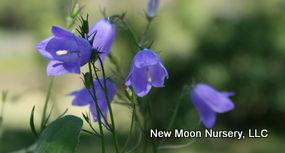Printed at http://www.newmoonnursery.com/index.cfm/
Campanula rotundifolia
Harebell (No Advance Orders)
Native to North America
NO ADVANCE ORDERS (NAO) - A selection of plants are NAO-No Advanced Orders. They have proved to be tricky; acquiring propagules, producing them, or getting them through the winter. We only put them on our availability lists when they are ready to ship. No hopes dashed. Plants must ship within 2 weeks or their availability date.
FIRST IMPRESSIONS: Campanula rotundifolia is a slender rhizomatous perennial wildflower. Foliage is bright green and rounded, heart shaped or linear on various parts of the plant. In summer, pendant bell shaped violet blooms are borne in terminal racemes. Plants are often described as having a delicate appearance but as far as culture goes, they are tough as nails. They flourish in harsh sites like dry grasslands and can even thrive in rock crevices. This charmer would be a delightful addition to a cottage garden or rock garden where the blossoms can provide tasty nectar for bees.
HABITAT & HARDINESS: Native to Canada, Great Britain and northern Europe. Occurs through most of the United States except for Nevada, Kansas, Oklahoma and the southeastern states. Campanula rotundifolia is indigenous to sandy oak savannas, dry prairies and grasslands, heaths, crevices of limestone or dolomite rock formations, gravelly deposits along creeks and roadsides. Plants are found most often in undisturbed habitats with rocky slopes.
Hardy from USDA Zones 3-8.
PLANT DESCRIPTION: Campanula rotundifolia is an upright unbranched wildling that is anchored by a sturdy taproot. Plants produce several erect stems from an underground rhizome.
The toothed basal leaves are bright green and rounded. Upper leaves are narrower and either heart shaped or linear.
The stems terminate in a dazzling raceme of violet bell shaped florets that dangle from slender stalks. The florets are less than 1” long with 5 curved lobes. They are frequented by butterflies and bees from summer into the fall. The resulting fruit is an unobtrusive oval capsule that is full of tiny seed.
Plants usually attain a height of 6-18” and a 1’ spread.
CULTURAL & MAINTENANCE NEEDS: Campanula rotundifolia grows best in sunny or lightly shaded sites with good drainage.
Plants tolerate drought, shallow rocky infertile sites and acid or alkaline soils. Plants will decline if shaded by aggressive companions.
In a happy setting, Campanula rotundifolia will reseed. Seedlings often settle into cracks in cliff faces or retaining walls. Plants are fairly pest resistant but are occasionally nibbled by deer and other herbivores.
LANDSCAPE USES: Plants are perfect candidates for the Cottage Garden or Wildlife Garden. Campanula rotundifolia is also used as an Accent or Butterfly Nectar Plant. Plants provide Showy Blooms and are valuable components of Rock Gardens, Water-wise Landscapes, Low Maintenance Plantings, Perennial Borders and Meadows.
COMPANION & UNDERSTUDY PLANTS: In a butterfly garden, Campanula rotundifolia plays well with Amsonia illustris, Asclepia tuberosa, Helenium autumnale, Liatris microcephala, and Monarda fistulosa.
Aquilegia canadensis can be substituted for this plant in a slightly shadier site. These two are very different in appearance but have similar cultural needs.
TRIVIA: This plant is a member of the Bellflower family with a colorful folkloric history. In Scotland it is the symbol of the MacDonald clan. It is known as Bluebell and was once used in the manufacture of a blue dye used to tint tartans. Throughout Britain it was believed that fairies lived inside the flowers. It was called Devil’s Bells or Dead Man’s Bells due to the bell shaped flowers’ association with funeral bells. Witches were said to use the plant in their “flying” ointment.
Height:
6-18 InchesSpread:
1 ftSpacing:
18-24 inUSDA Hardiness Zone:
3-8Bloom Color:
BlueCampanula rotundifolia Characteristics
Attracts Wildlife
- Butterflies
- Pollinators
Attributes
- Naturalizing
- Ground Cover
- East-Coast Native
- Drought Tolerant
Exposure
- Full Sun to Partial Shade
Deer Resistant
- Deer Resistant
Flowering Months
- June
- July
Foliage Color
- Green
Growth Rate
- Medium
Juglans nigra Tolerance (Black Walnut)
- Yes
Season of Interest (Foliage)
- Spring
- Summer
Soil Moisture Preference
- Dry to Moist
Interesting Notes:
For more information on this plant, visit the USDA PLANTS Database: http://plants.usda.gov/java/profile?symbol=CARO2

